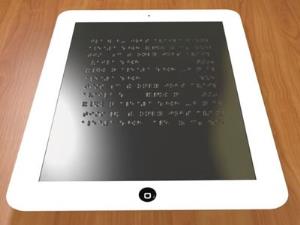



Date:06/04/20
 Blind readers will likely be familiar with refreshable braille displays, in which raised dots electronically rise and fall from a flat surface in order to temporarily form braille characters. A new material, however, could make such displays cheaper and more useful than ever before.
Blind readers will likely be familiar with refreshable braille displays, in which raised dots electronically rise and fall from a flat surface in order to temporarily form braille characters. A new material, however, could make such displays cheaper and more useful than ever before.
Currently, most refreshable braille displays utilize a piezoelectric effect. This involves applying voltage to a small crystal, which responds by expanding and thus pushing a pin upwards. The top of that pin creates a raised dot that can be felt by the fingertips.
Eight such dots make up a single character, and a typical display can only show a maximum of 80 such characters at once. This limits the speed at which users can read, potentially making it a relatively clumsy process.
Displays utilizing electroactive polymers (EAPs) have been put forward as an alternative, as they're able to show much more text at one time, plus they can be used to present other types of tactile content, such as images. They would also likely be cheaper and easier to manufacture. On the downside, though, prototypes produced so far have required high voltages in order to work properly, and they haven't been very durable.
Led by Dr. Julia R. Greer, a team from the California Institute of Technology is developing a new "polyionic" EAP that lacks these limitations. It takes the form of a gel made up of linked chains of polymers – some of those chains are positively-charged, and some are negatively-charged.
Ordinarily, the two types of chains stick together. When a relatively weak voltage is applied, however, they respond by repelling one another. This causes the gel to expand, forming a dot-like bump. Once the voltage is removed, though, the chains go back together, and the gel flattens down again.
It is believed that displays made with the polyionic EAP should be significantly more resilient and energy-efficient than those made of traditional EAPs, while still offering all the benefits of the latter. And because the gel is capable of generating an electrical signal in response to applied pressure, the displays could conceivably respond to touch, not unlike a smartphone's touchscreen.
"Polyionic" material may make for better braille displays
 Blind readers will likely be familiar with refreshable braille displays, in which raised dots electronically rise and fall from a flat surface in order to temporarily form braille characters. A new material, however, could make such displays cheaper and more useful than ever before.
Blind readers will likely be familiar with refreshable braille displays, in which raised dots electronically rise and fall from a flat surface in order to temporarily form braille characters. A new material, however, could make such displays cheaper and more useful than ever before.Currently, most refreshable braille displays utilize a piezoelectric effect. This involves applying voltage to a small crystal, which responds by expanding and thus pushing a pin upwards. The top of that pin creates a raised dot that can be felt by the fingertips.
Eight such dots make up a single character, and a typical display can only show a maximum of 80 such characters at once. This limits the speed at which users can read, potentially making it a relatively clumsy process.
Displays utilizing electroactive polymers (EAPs) have been put forward as an alternative, as they're able to show much more text at one time, plus they can be used to present other types of tactile content, such as images. They would also likely be cheaper and easier to manufacture. On the downside, though, prototypes produced so far have required high voltages in order to work properly, and they haven't been very durable.
Led by Dr. Julia R. Greer, a team from the California Institute of Technology is developing a new "polyionic" EAP that lacks these limitations. It takes the form of a gel made up of linked chains of polymers – some of those chains are positively-charged, and some are negatively-charged.
Ordinarily, the two types of chains stick together. When a relatively weak voltage is applied, however, they respond by repelling one another. This causes the gel to expand, forming a dot-like bump. Once the voltage is removed, though, the chains go back together, and the gel flattens down again.
It is believed that displays made with the polyionic EAP should be significantly more resilient and energy-efficient than those made of traditional EAPs, while still offering all the benefits of the latter. And because the gel is capable of generating an electrical signal in response to applied pressure, the displays could conceivably respond to touch, not unlike a smartphone's touchscreen.
Views: 380
©ictnews.az. All rights reserved.Similar news
- Azerbaijani project to monitor disease via mobile phones
- Innovative educational system to be improved under presidential decree
- NTRC prolongs license of two TV and radio organizations for 6 years
- Azerbaijan establishes e-registry for medicines
- Azerbaijani museum introduces e-guide
- Nar Mobile opens “Nar Dunyasi” sales and service center in Siyazan city
- International conference on custom electronic services held in Baku
- OIC secretary general to attend COMSTECH meeting in Baku
- Azerbaijan develops earthquake warning system
- New law to regulate transition to digital broadcasting in Azerbaijan
- Azerbaijani State Social Protection Fund introduces electronic digital signature
- Intellectual traffic management system in Baku to be commissioned in December
- Tax Ministry of Azerbaijan started receiving video-addresses
- World Bank recommends Azerbaijan to speed up e-service introduction in real estate
- Azerbaijan to shift to electronic registration of real estate





















